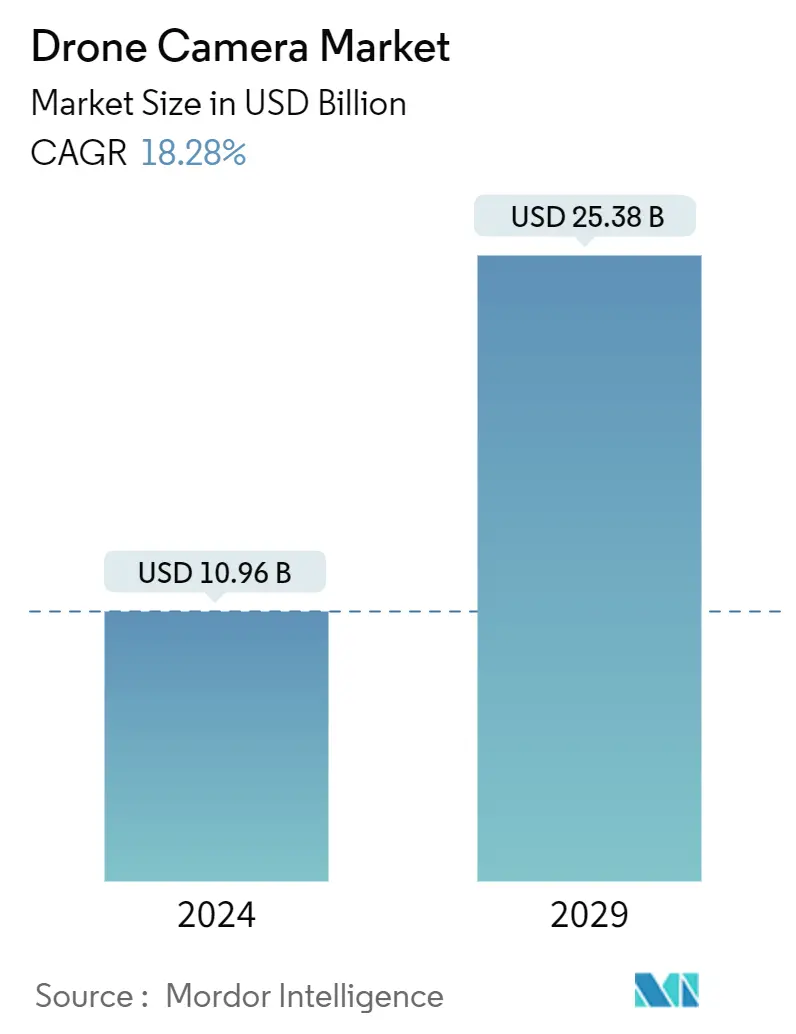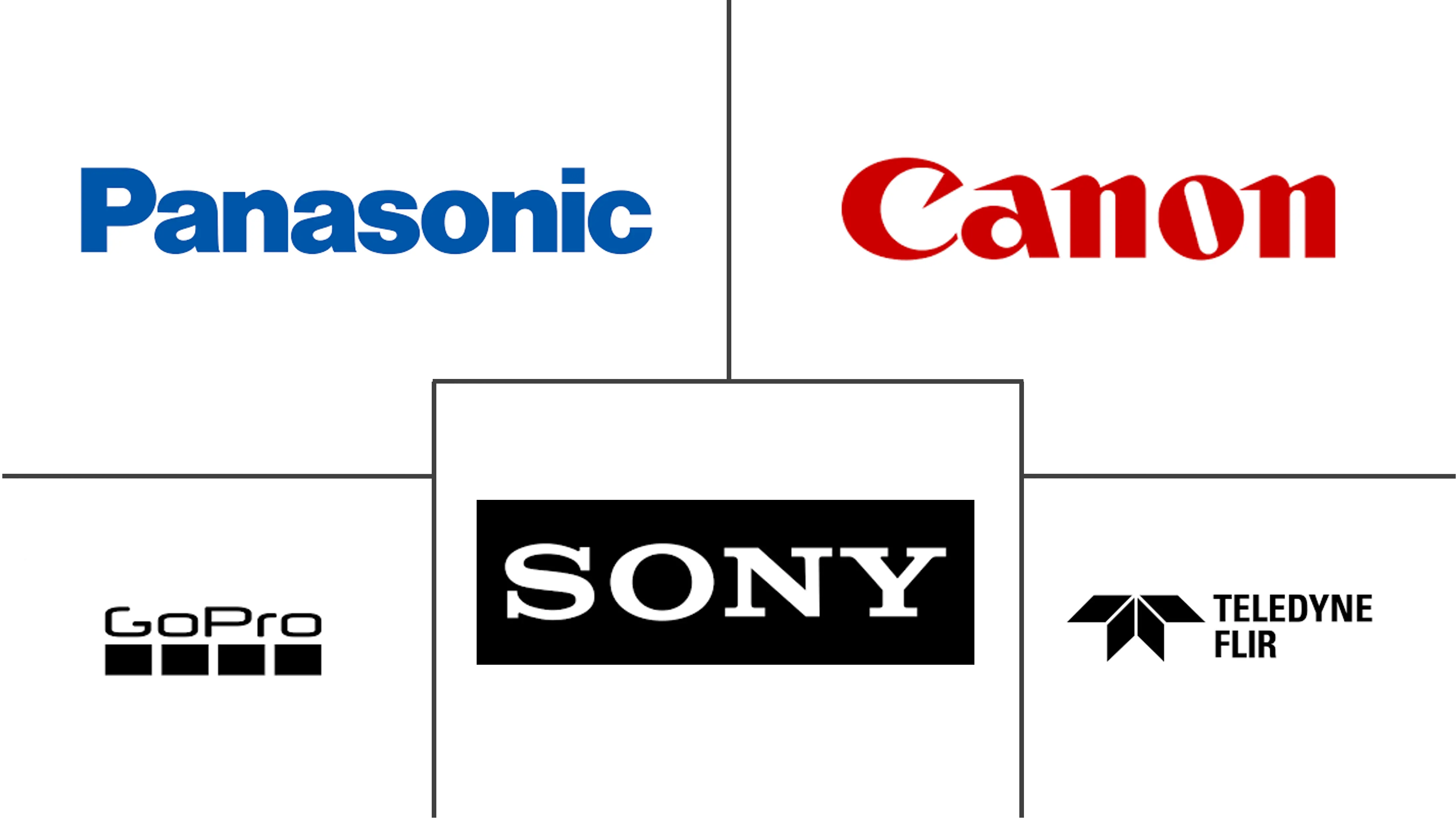
| Study Period | 2019 - 2029 |
| Market Size (2024) | USD 10.96 Billion |
| Market Size (2029) | USD 25.38 Billion |
| CAGR (2024 - 2029) | 18.28 % |
| Fastest Growing Market | Asia-Pacific |
| Largest Market | North America |
| Market Concentration | Medium |
Major Players
*Disclaimer: Major Players sorted in no particular order |
Drone Camera Market Analysis
The Drone Camera Market size is estimated at USD 10.96 billion in 2024, and is expected to reach USD 25.38 billion by 2029, growing at a CAGR of 18.28% during the forecast period (2024-2029).
Increasing demand for aerial photography and videography, along with reduced drone costs, is a major factor driving the market growth. Drone cameras are less expensive compared to traditional camera equipment for collecting high-quality footage. Aerial surveillance is required in situations such as crowded gatherings, large sports competitions, and summer festivals. Moreover, the growing use of drone cameras for real estate photography, mapping and surveying, agriculture, emergency response, search and rescue operations, maritime rescue, meteorology, and delivery, among other things, is driving the drone camera market.
The ability of these UAVs to aid in ISR missions, aerial surveillance, and tactical operations is likely to result in their increasing adoption of drones with camera features during the forecast period. Drones generally fly low and slow and are hard to detect and hear. In addition, they are incredibly cheap platforms, challenging defense systems to find ways of defeating them without creating an unacceptable cost-exchange ratio.
The latest technological advancements, particularly in camera quality and stabilization, are major factors driving the adoption of drones with cameras. Higher resolution cameras, improved image processing capabilities, and improved battery life are making drones more attractive for various applications. Increasing adoption of drones across industries such as media and entertainment and public safety is also fuelling market growth.
The investments in drone startups grew strongly. Investors recognized the huge potential of drones across numerous industries, leading to a growing number of funding rounds and capital investments into drone startups. This inflow of capital is enabling these startup companies to innovate and develop cutting-edge technologies, further expanding the capabilities of drones and driving the drone camera market growth.
However, the misuse of drones by evil entities to conduct physical and cyber-attacks is a major threat to public safety. In recent years, many technical and operational drone properties were misused for potential attacks. It includes performing critical operations based on violent reconnaissance and surveillance aimed at tracking specific people and certain properties, leading to safety and privacy issues. Hacking a drone is like hacking into a personal computer. Hackers need to connect to the drone by intercepting the signal, where the radio signal is unencrypted and decoded with a packet sniffer. After this, the hackers block the signal, connect the drone to their device, and manipulate the gadget to work as they want. Such security challenges lead to hesitations for the government to adopt drone services across various sectors, eventually hampering the drone camera market.
Drone Camera Industry Segmentation
A drone camera is an unmanned aerial vehicle (UAV) equipped with a camera that can capture photographs and videos. It is integrated with sensors that enhance the resolution and stabilize systems. It helps to provide an autonomous vision while reducing the need to physically inspect the drone and its position in the sky. It also helps with other activities, including product and food delivery, surveillance over a small region, and thermal imaging. As a result, a drone camera may be found in a variety of industrial verticals across the globe.
The drone camera market is segmented based on type, application, resolution, end user, and geography. Based on the type, the drone camera market is segmented into SD cameras and HD cameras. By application into photography & videography, thermal imaging, and surveillance. By resolution, the market is segmented into 12 MP, 12 to 20 MP, 20 to 32 MP, and 32 MP & above. By end user, the market is segmented into commercial, military, and homeland security. The report also covers the market sizes and forecasts for the aircraft tire market in major countries across different regions. For each segment, the market size is provided in terms of value (USD).
| SD Cameras |
| HD Cameras |
| Photography & Videography |
| Thermal Imaging |
| Surveillance |
| Commercial |
| 12 MP |
| 12 to 20 MP |
| 20 to 32 MP |
| 32 MP and above |
| Military |
| Homeland Security |
| North America | United States |
| Canada | |
| Europe | United Kingdom |
| Germany | |
| France | |
| Italy | |
| Rest of Europe | |
| Asia-Pacific | China |
| India | |
| Japan | |
| South Korea | |
| Rest of Asia-Pacific | |
| Latin America | Brazil |
| Rest of Latin America | |
| Middle-East and Africa | United Arab Emirates |
| Saudi Arabia | |
| Egypt | |
| Rest of Middle-East and Africa |
Drone Camera Market Size Summary
The drone camera market is poised for significant growth, driven by increasing demand for aerial photography and videography, alongside the decreasing costs of drone technology. This market expansion is fueled by the versatility of drone cameras, which are being utilized across various sectors such as real estate, agriculture, emergency response, and public safety. The ability of drones to perform tasks like aerial surveillance, mapping, and delivery, combined with advancements in camera quality and stabilization, has made them an attractive option compared to traditional methods. The influx of investments in drone startups further propels innovation, enhancing the capabilities of drone cameras and broadening their application scope. However, concerns regarding the misuse of drones for malicious activities pose challenges to market adoption, particularly in sensitive sectors.
The surveillance segment is expected to dominate the drone camera market, with law enforcement agencies increasingly relying on drones for tasks such as crowd monitoring, crime scene investigation, and border security. The Asia-Pacific region is anticipated to experience rapid growth due to the adoption of drones in agriculture and other industries, driven by technological advancements and digitalization efforts. The market is semi-consolidated, with major players like Sony, Panasonic, and Canon holding significant shares, while numerous startups contribute to competitive dynamics. Companies are focusing on integrating artificial intelligence and machine learning into drone cameras to enhance functionality and expand applications. The development of advanced features such as object tracking and autonomous flight capabilities is expected to further drive market growth, as seen in recent product launches and innovations.
Drone Camera Market Size - Table of Contents
1. MARKET DYNAMICS
- 1.1 Market Overview
- 1.2 Market Drivers
- 1.3 Market Restraints
-
1.4 Porter's Five Forces Analysis
- 1.4.1 Bargaining Power of Suppliers
- 1.4.2 Bargaining Power of Buyers/Consumers
- 1.4.3 Threat of New Entrants
- 1.4.4 Threat of Substitute Products
- 1.4.5 Intensity of Competitive Rivalry
2. MARKET SEGMENTATION
-
2.1 Type
- 2.1.1 SD Cameras
- 2.1.2 HD Cameras
-
2.2 Application
- 2.2.1 Photography & Videography
- 2.2.2 Thermal Imaging
- 2.2.3 Surveillance
-
2.3 Resolution
- 2.3.1 12 MP
- 2.3.2 12 to 20 MP
- 2.3.3 20 to 32 MP
- 2.3.4 32 MP and above
-
2.4 Application
- 2.4.1 Commercial
- 2.4.2 Military
- 2.4.3 Homeland Security
-
2.5 Geography
- 2.5.1 North America
- 2.5.1.1 United States
- 2.5.1.2 Canada
- 2.5.2 Europe
- 2.5.2.1 United Kingdom
- 2.5.2.2 Germany
- 2.5.2.3 France
- 2.5.2.4 Italy
- 2.5.2.5 Rest of Europe
- 2.5.3 Asia-Pacific
- 2.5.3.1 China
- 2.5.3.2 India
- 2.5.3.3 Japan
- 2.5.3.4 South Korea
- 2.5.3.5 Rest of Asia-Pacific
- 2.5.4 Latin America
- 2.5.4.1 Brazil
- 2.5.4.2 Rest of Latin America
- 2.5.5 Middle-East and Africa
- 2.5.5.1 United Arab Emirates
- 2.5.5.2 Saudi Arabia
- 2.5.5.3 Egypt
- 2.5.5.4 Rest of Middle-East and Africa
Drone Camera Market Research FAQs
How big is the Drone Camera Market?
The Drone Camera Market size is expected to reach USD 10.96 billion in 2024 and grow at a CAGR of 18.28% to reach USD 25.38 billion by 2029.
What is the current Drone Camera Market size?
In 2024, the Drone Camera Market size is expected to reach USD 10.96 billion.


